 |
||
|
||
| ||
Today we will examine some representatives of a famous clan of hard discs produced by Maxtor. Here are they: Maxtor DiamondMax Plus 60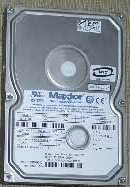 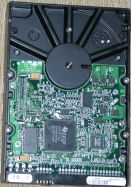 The Maxtor DiamondMax Plus 60 is a series of hard discs with a spindle rotation speed equal to 7200 rpm and a capacity varying from 10.2 to 60.5 GB. Usage of the proprietary technology DualWavE(TM) is what differs them from other similar devices. Together with a signal processor (DSP) from Texas Instruments we have here a special RISC-processor developed by Maxtor, which deals only with instruction processing. This technology helps to save nearly 90% of instruction processing time. A simple operation of the DualWave(TM) looks the following way. 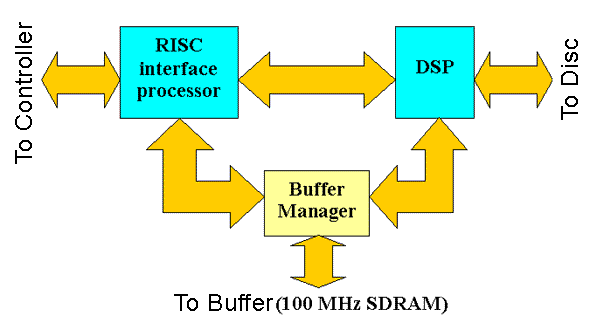 Other characteristics are usual: 20 GBytes per platter, Ultra ATA/100 interface. We tested the 40 GBytes model. Maxtor DiamondMax VL40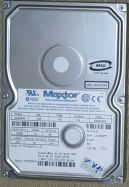 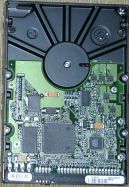 The Maxtor DiamondMax VL40 is a series of hard discs with 5400 rpm spindle rotation speed. The capacity varies from 10 to 40 GBytes (as a rule, a name of Maxtor series indicated the maximum disc capacity). Besides, the discs have 20 GBytes per platter and Ultra ATA/100 interface. The series is based on the SilentStore(TM) technology for improving acoustic characteristics and the Adaptive ATA Control (TM) technology. Unfortunately, there is no more information about these technologies. We tested a disc of 40 GBytes capacity. Maxtor DiamondMax VL15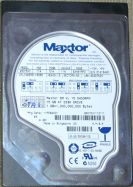 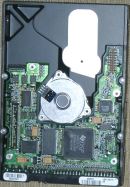 It is the most interesting participant today. First of all, because this series of Maxtor is absent!!! By comparing model numbers (2R015H1) we have found out that this model belongs to the 531DX series. I don't know the reason of such descrepancy. In general, the series is very interesting. It consists of two models - 2R015H1 and 2R010H1 which are positioned as discs for entry-level computers and home electronic systems. According to the markings of the models, both discs have one head. It means that a record density per one platter makes ... 30 GB! Not so bad for an entry level. And taking into consideration that on the 4 June the company started shipping 541DX discs with one head and 20 GBytes capacity, the situation becomes intriguing. But I must say that Maxtor nowhere mentions a platter density using only the term "areal density". And this is correct anyway, since only half of a platter is used. Such configuration of the disc made possible to reduce its width down to 17 mm, i.e. less than the standard by 38%.  One more technological innovation used in the 531/541DX series is a special load/unload ramp. With its help a head being in an idle state is put in a protective carrier in order to reduce the risk of damaging the disc during transportation. Another interesting feature is Acoustic Management function. The management is implemented by change of the head positioning speed with the AMSET utility (you can download it from here). This program works with discs of the following series:
and more modern ones. Apart from a normal mode ("off"), there are two grades of "silence": - "fast" and "quiet". In the "fast" mode the positioning speed is reduced not much not to affect the performance. In the "quiet" mode the performance is not taken into account: the aim is to reach the quietness. However, the utility yields to a compe titive program from IBM in the convenience of operation. First of all, you will have to make a DOS bootable diskette yourself. Secondly, the program works with the command promt. Thirdly, in the amset /check mode you can get the information only about the acoustic management mode status: enabled or disabled, and instead of marking the mode, you will see some unclear signs which you will have to compare with the mode (fast or quiet). All discs were shipped with the acoustic management function enabled in the "quiet" mode. The complete specifications of the discs can be found in the table. TestsThe tests were carried out according to our testing technique. But before I turn to the results, let me share my impressions of operation of the AMSET utility. It seems to me that apart from three above mentioned modes there is one more codenamed "out". Operation of this mode looks like this: first you start the AMSET utility for setting a disc in a definite mode and then begin testing this disc. Then you stares at the results and slowly slip down from a chair. Because the DiamondMax Plus 60 works slower than any other 5400 disc with the record density of 10 GBytes per platter! At the same time, the linear reading speed and the access time are quite normal. In my opinion, the problem lies in the cache-buffer operation. Anyway, you should be careful when using this utility. Ziff-Davis WinBench 99 - 7200 rpm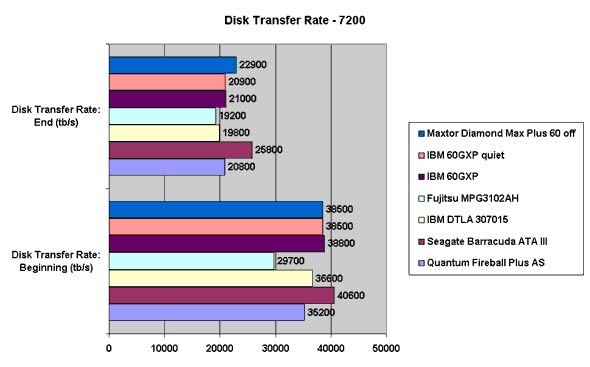 Since the acoustic management function doesn't influence a linear read speed, further we will disable this mode. The results of the DiamondMax Plus 60 are not bad. The Seagate Barracuda ATA III will probably remain a leader in this parameter among 20 GB-per-platter discs. And the Maxtor looks quite decent as compared with others. DiamondMax Plus 60 - 5T040H4 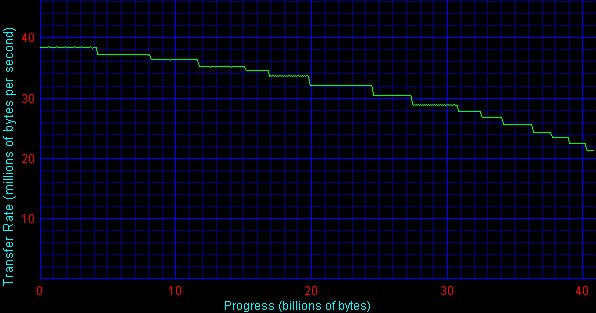 The DiamondMax Plus 60 has very good quality of the platters. 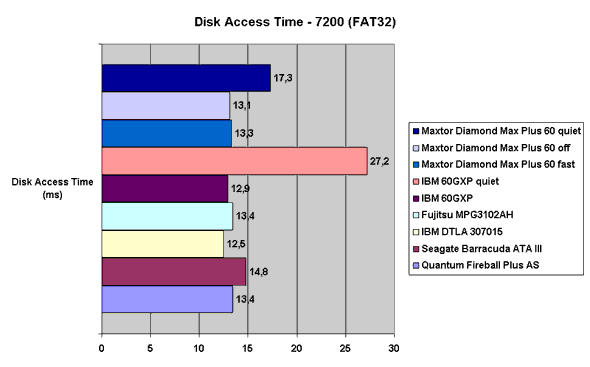 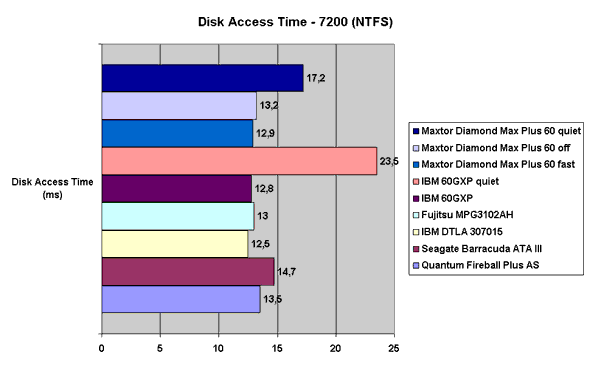 Here, the acoustic management if a key factor. The diagrams correspond to the "fast" and "quiet" modes. The Maxtor has fallen by a little margin from the IBM 60GXP (excluding the "quiet" mode of IBM). I must say that the test results coincide with the specified characteristics (13.1 ms against the specified 8.7+4.17=12.87 ms) 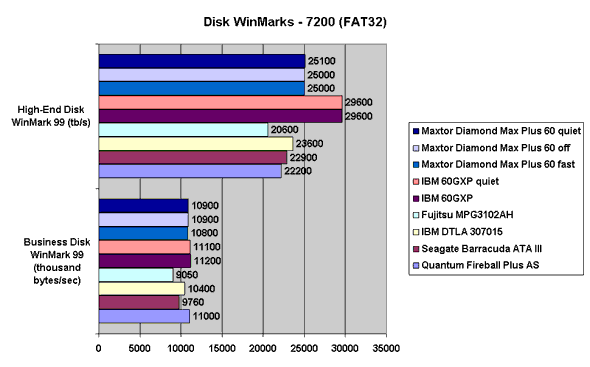 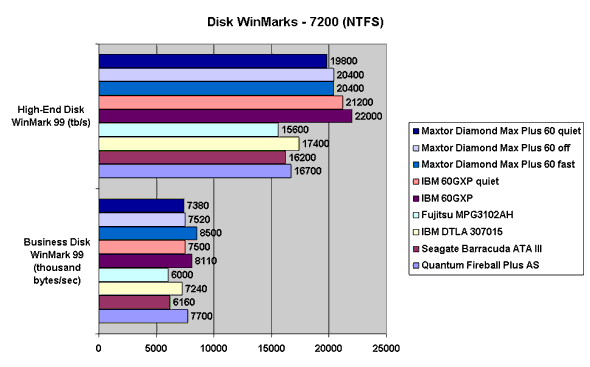 It is a solid second place in the High-End WinMark test. As for the Business WinMark, it seems that the disc prefers the NTFS J file system. It is interesting that the results of the FAT32 are nearly indifferent to the Acoustic Management mode. Maybe the reason is that we used a blank disc. Ziff-Davis WinBench 99 - 5400 rpm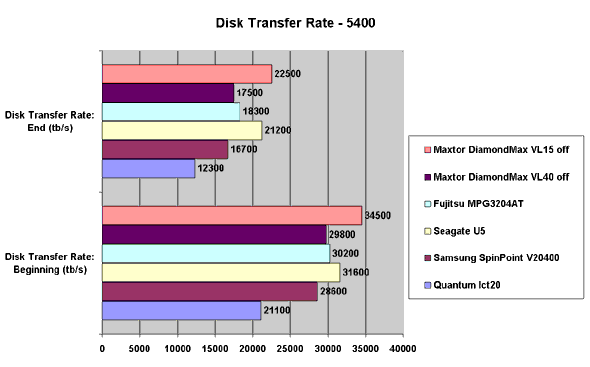 Well, 15 GBytes per head makes an effect - the VL15 is an unquestionable leader. And the VL40 disappointed us a bit - it yielded not only to the Seagate U5, but also to the Fujitsu MPG. As for the graphs of reading, DiamondMax VL40 - 34098H4  the VL40 has no problems here, DiamondMax VL15 - 2R015H1 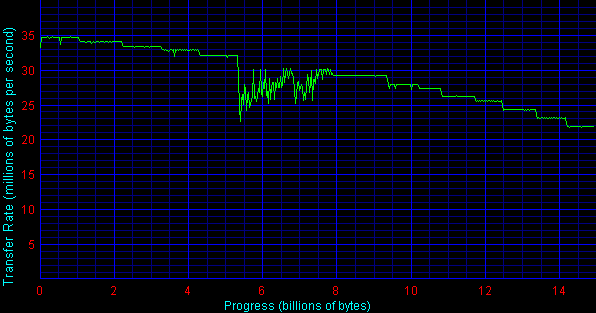 and the VL15 shows a well noticed saw in the center of the graph. 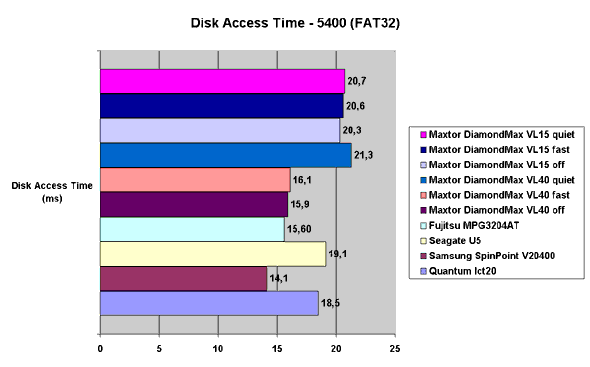 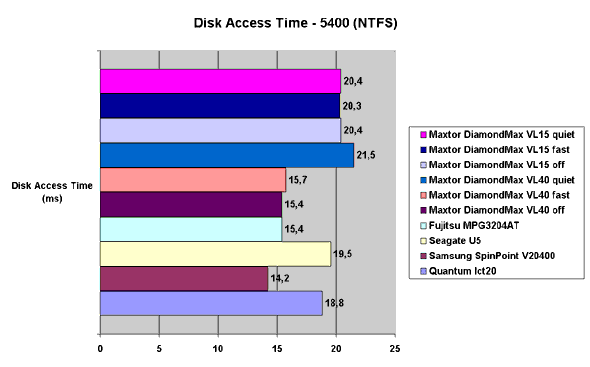 The VL40 demonstrated excellent results, which are very close to the specifications (15.6 and 15.4 ms against the specified 9.5+5.55=15.05 ms). The VL15 demonstrated an excellent coincidence: 20.3 and 20.4 ms are even less then the specified 15+5.55=20.55 ms. But I think that 15 ms Average Seek Time for a disc with a such record density is a bit too much. And it makes me think that it won't let the disc excel in other tests. Besides, the access time of the VL15 doesn't depend on the Acoustic Management settings. It seems that this function is not supported by the disc, though the utility reports that one or another mode is set. 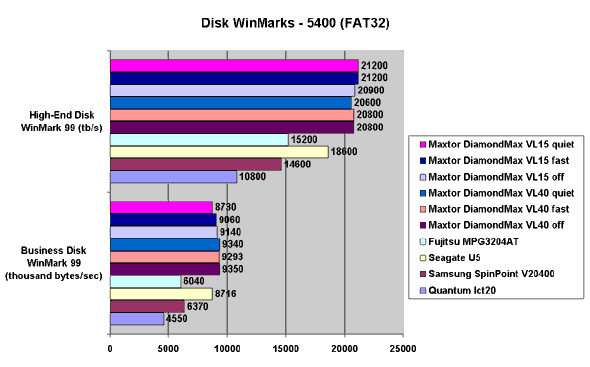 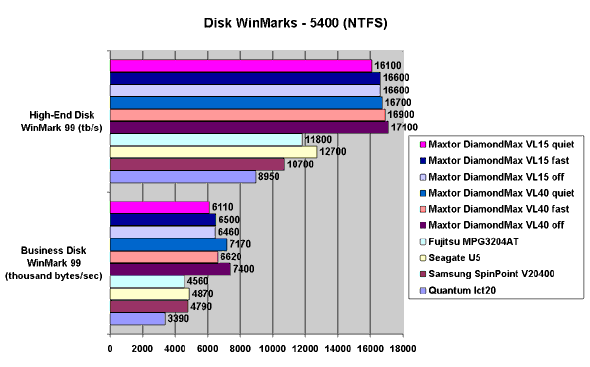 The dismal forecasts haven't come true. Of course, we could have expected better results with a such record density, however the VL15 performs already as good as a new leader which is now the Maxtor DiamondMax VL40. But its leadership mustn't last long. Right now we, in our lab, are testing a Western Digital Caviar 300AB disc with true 30 GBytes per platter. I don't doubt that it will take the lead. The full results can be found in the table. Intel IOMeterIn this test, at the low load an access time plays the most important role, and at the higher load the stress is laid upon the firmware. Taking it into consideration, I may assume, that the "off" and "fast" modes won't differ much. And this has appeared to be true. That is why I have given graphs for "off" and "quiet" modes for all discs, except the VL15. This one has nearly the same results for all three modes (the results are shown in the table).  The Maxtor DiamondMax Plus 60, Quantum Fireball Plus AS and Fujitsu MPG AH performed at the same level. But the IBM outscored them all. In the "quiet" mode the results are becoming closer as the load grows. 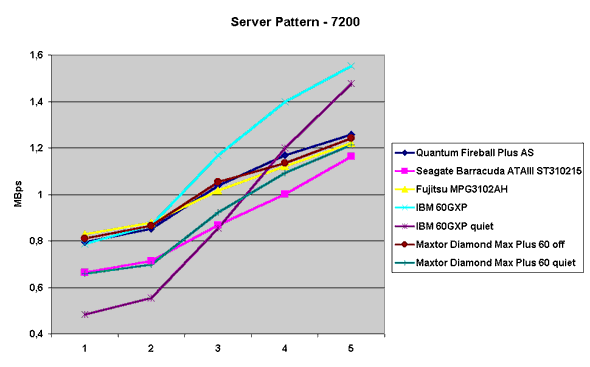 The situation is absolutely the same. 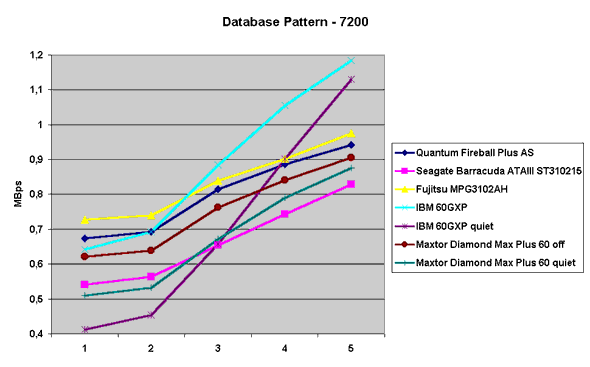 The gaps between the competitors became larger, and the Maxtor came the last.  The VL15, despite its large access time, turned to be a leader, and the VL40 appeared among the losers. It seems that the disc is not optimized for heavy loads. On the other hand, this might be right - it is a 5400 rpm disc and it will be used for entry-level computers or as a bulk storage device. 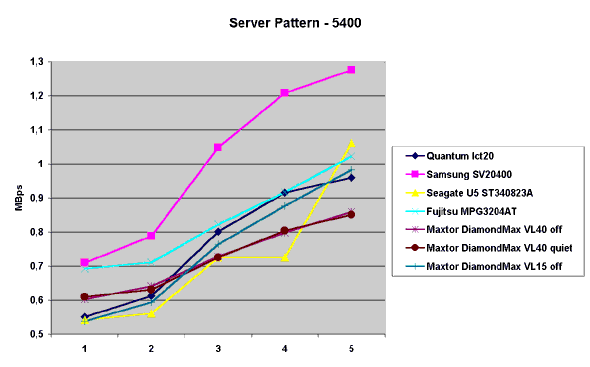 Both Maxtor discs have nothing to boast of. But it is not a tragedy since one would hardly use this discs in servers. 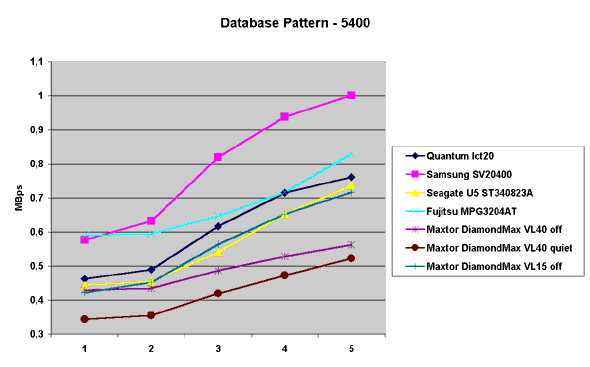 The VL15 follows the Seagate U5 (they have close access time). I just don't understand the low result of the VL40. Acoustic ManagementWhat about the noise? The discs have it very similar to the other competitors. The "fast" mode doesn't allow for a considerable noise elimination. The "quiet" one reduces the noise quite good in the DiamondMax Plus 60 and VL40, though the IBM is still above them, and it can be explained: just look at the access time diagrams. As for the VL15, I haven't noticed any changes in the acoustic characteristics. ConclusionMaxtor produces very good discs. The DiamondMax
Plus 60 series can be recommended almost for all of you who want
a 7200 rpm disc. The DiamondMax VL40 is a new leader among 5400
rpm discs. The DiamondMax VL15 series is more interesting due to
its original technical solutions. Besides, their performance is
also very good.
Write a comment below. No registration needed!
|
Platform · Video · Multimedia · Mobile · Other || About us & Privacy policy · Twitter · Facebook Copyright © Byrds Research & Publishing, Ltd., 1997–2011. All rights reserved. |